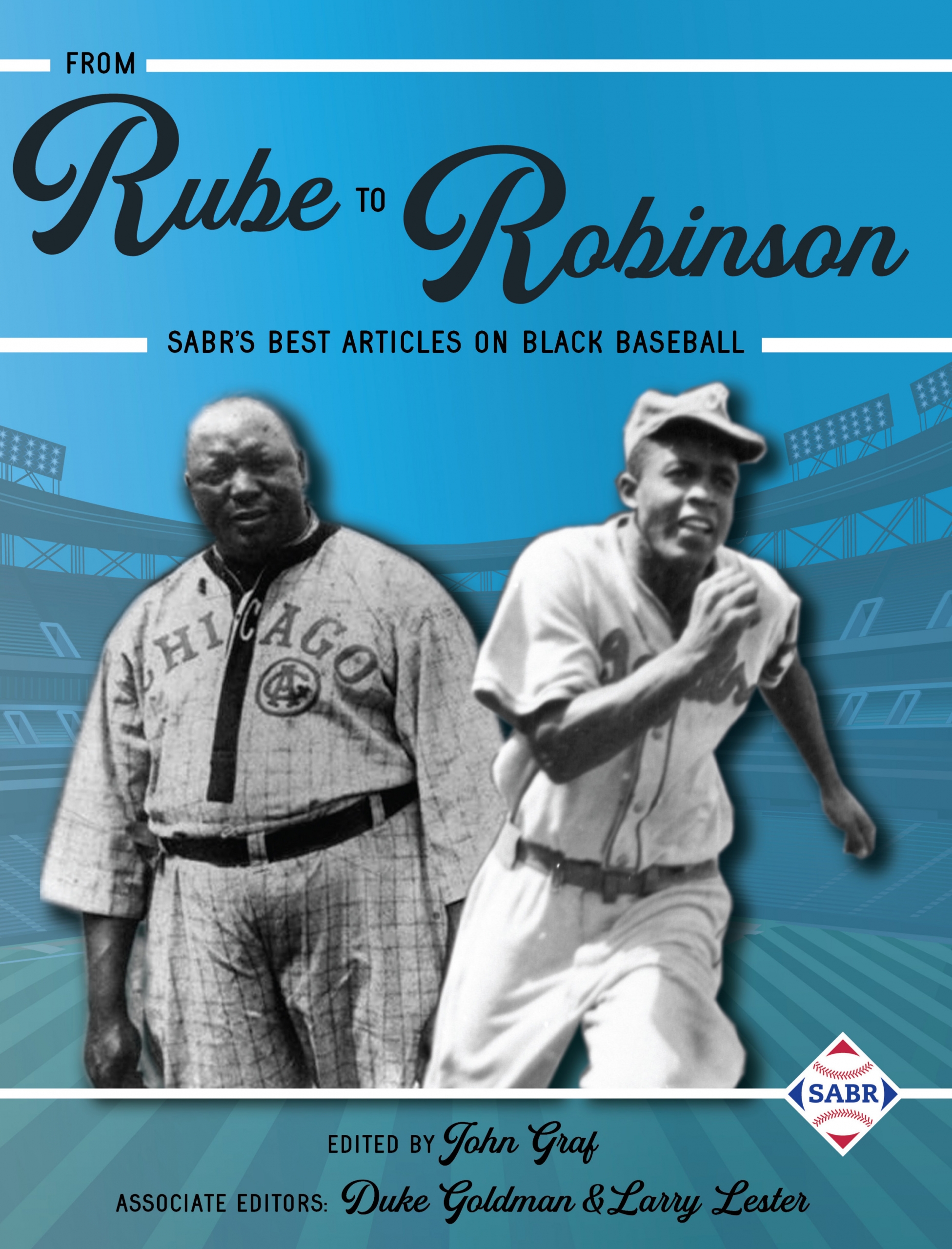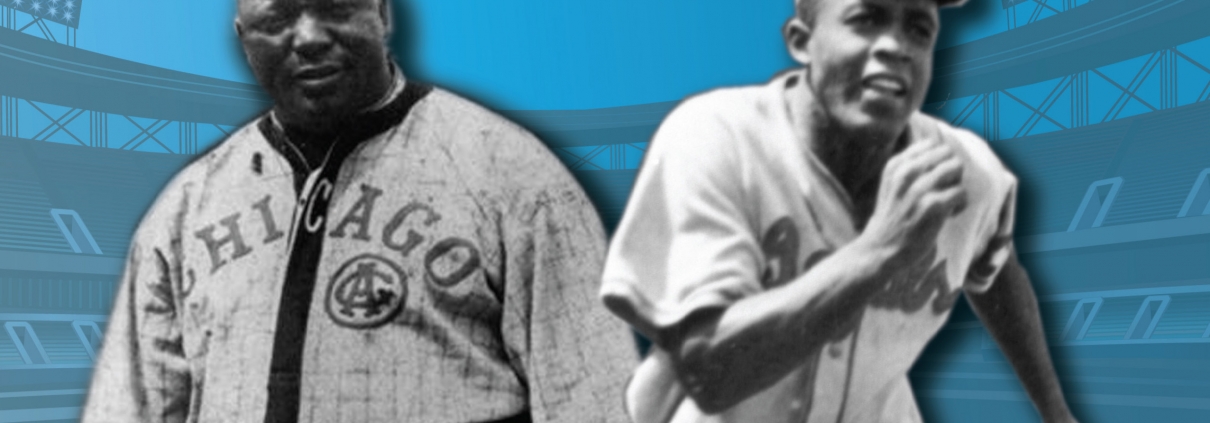SABR Digital Library: From Rube to Robinson: SABR’s Best Articles on Black Baseball
Add a new baseball book to your collection from the SABR Digital Library:
 From Rube to Robinson: SABR’s Best Articles on Black Baseball
From Rube to Robinson: SABR’s Best Articles on Black Baseball
Edited by John Graf
Associate editors: Duke Goldman and Larry Lester
ISBN (paperback): 978-1-9701-5941-7, $24.95
ISBN (ebook): 978-1-9701-5940-0, $9.99
8.5″ x 11″, 218 pages
From Rube to Robinson brings together the best Negro League baseball scholarship that SABR has ever produced, pulled from its journals, Biography Project, and award-winning essays. The book includes a star-studded list of scholars and historians, from the late Jerry Malloy and Jules Tygiel, to award winners Larry Lester, Geri Strecker, and Jeremy Beer, and a host of other talented writers. The essays cover topics ranging over nearly a century, from 1866 and the earliest known Black baseball championship, to 1962 and the end of the Negro American League.
Todd Peterson’s “May the Best Man Win: The Black Ball Championships 1866-1923” opens the volume and looks at championships that preceded the Colored World Series of 1924. The late Jerry Malloy covers an early circuit in “The Pittsburgh Keystones and the 1887 Colored League.” Malloy points out that the short-lived league garnered the acceptance of the National Agreement of 1883, something no other Black organization was able to do.
Not only did Black baseball begin earlier than most fans of the sport may realize, it took root in places that might not be expected, either. Steven R. Hoffbeck and Peter Gorton tell the story of legendary southpaw John Donaldson, who pioneered baseball in Minnesota and who would eventually be part of the NNL’s 1920 inaugural season with the Kansas City Monarchs.
Two seminal Negro Leagues researchers — Dick Clark and John Holway — place the 1921 NNL season in context, including a sidebar from the original 1985 article detailing the SABR Negro Leagues Committee’s efforts to compile a statistical history.
Of course, there are also profiles of some of the Negro Leagues’ now-mythic figures: Sol White (by Jay Hurd), Rube Foster (by Larry Lester), and Oscar Charleston. Jeremy Beer contributes his article “Hothead: How the Oscar Charleston Myth Began,” which rebuts the notion that Charleston was a brawler in need of anger management.
Ballparks and venues also get a look, with a major league field and a Negro League field included. James Overmyer’s “Black Baseball at Yankee Stadium” describes the tenant/landlord relationship of Negro Leagues teams with the New York Yankees during the 1930s and ’40s, while Geri Driscoll Strecker’s “The Rise and Fall of Greenlee Field” is a cradle-to-grave biography of the Pittsburgh Crawfords’ stadium.
The final section of the book covers integration and the socio-economics of Black baseball. Leading off is Larry Lester’s masterful “Can You Read, Judge Landis?” which refutes the contention that Judge Kenesaw Mountain Landis was blameless for the persistence of baseball’s segregation. MLB’s official historian, John Thorn, and the late Jules Tygiel weigh in with “Jackie Robinson’s Signing: The Real, Untold Story.” And Japheth Knopp’s “Negro League Baseball, Black Community, and the Socio-Economic Impact of Integration” explores Kansas City as a case study in the effects of integration.
Brian Carroll’s “Early Twentieth Century Heroes: Coverage of Negro League Baseball in the Pittsburgh Courier and the Chicago Defender” studies the cooperation among the African American press, local business communities, and baseball men such as Rube Foster to form the Negro National League, and later, the Eastern Colored League. And Duke Goldman presents an in-depth and meticulously referenced recap of the winter meetings and in-season owners meetings from the formation of a second Negro National League in 1933 through the last gasp of the Negro American League in 1962.
SABR members, get this e-book for FREE!
- E-book: Click here to download the e-book version of From Rube to Robinson for FREE from the SABR Store. Available in PDF, MOBI, and EPUB/Kindle formats.
- Paperback: Get a 50% discount on the From Rube to Robinson paperback edition from the SABR Store ($17.95 includes shipping/tax; delivery via Kindle Direct Publishing can take up to 4-6 weeks.)
Buy the book
- E-book: Click here to download the e-book version of From Rube to Robinson for $9.99 from the SABR Store. Available in PDF, MOBI, and EPUB/Kindle formats.
- Paperback: Get the paperback edition of From Rube to Robinson from the SABR Store ($34.95 includes shipping/tax; delivery via Kindle Direct Publishing can take up to 4-6 weeks.)
About the SABR Digital Library
For more than 40 years, SABR and its members have led the way in publishing the best baseball historical and statistical research. Our publications program is shifting to take advantage of new methods of publishing. Not only will we continue to publish new books like Can He Play? A Look At Baseball Scouts and Their Profession (2011); Detroit Tigers 1984: What A Start! What A Finish! (2012); Sweet ’60: The 1960 Pittsburgh Pirates (2013); Inventing Baseball: The 100 Greatest Games of the 19th Century (2013); Scandal on the South Side: The 1919 Chicago White Sox (2015); Nuclear Powered Baseball/The Simpsons (2016), Au jeu/Play Ball: The 50 Greatest Games in the History of the Montreal Expos (2016); Cuban Baseball Legends (2016); No-Hitters (2017); Bittersweet Goodbye: The Black Barons, the Grays, and the 1948 Negro League World Series (2017), Major League Baseball A Mile High: The First Quarter Century of the Colorado Rockies (2018), The 1995 Cleveland Indians: The Sleeping Giant Awakes (2019), and The Pride of Smoketown: The 1935 Pittsburgh Crawfords (2020), which showcase the best efforts of SABR’s members, chapters and committees, but new technology makes it possible for us to bring out-of-print titles like Nineteenth Century Stars (2012); The Fenway Project (2013); The 1967 Impossible Dream Red Sox: Pandemonium on the Field (2017); Go-Go to Glory: The 1959 Chicago White Sox (2019); and Green Cathedrals (2020) back again.
Books will be available in digital formats as well as paperbacks produced by “print on demand” (POD).
SABR members will get discounted rates for all Digital Library publications, including many for free. If you’re not a member, click here to join SABR.
Stay tuned throughout the year for new (and old!) titles that we’ll be adding to the SABR Digital Library. To learn more about SABR Publications, contact Publications Editor Cecilia Tan at ctan@sabr.org.
- Having trouble downloading our e-books? Click here for step-by-step instructions or a short tutorial video on how to download SABR digital publications.
- Note for Kindle users: Amazon no longer allows Kindle users to send new MOBI files to their Kindle library. (Any MOBI files already in your Kindle library will not be affected by this change.) Compatible formats for Kindle e-readers now include EPUB (.epub), which you can download and send to your library using your Send to Kindle email address. Amazon will also be adding EPUB support to the free Kindle app for iOS and Android devices and the Send to Kindle desktop app for PC and Mac.
Originally published: February 16, 2021. Last Updated: December 13, 2024.


